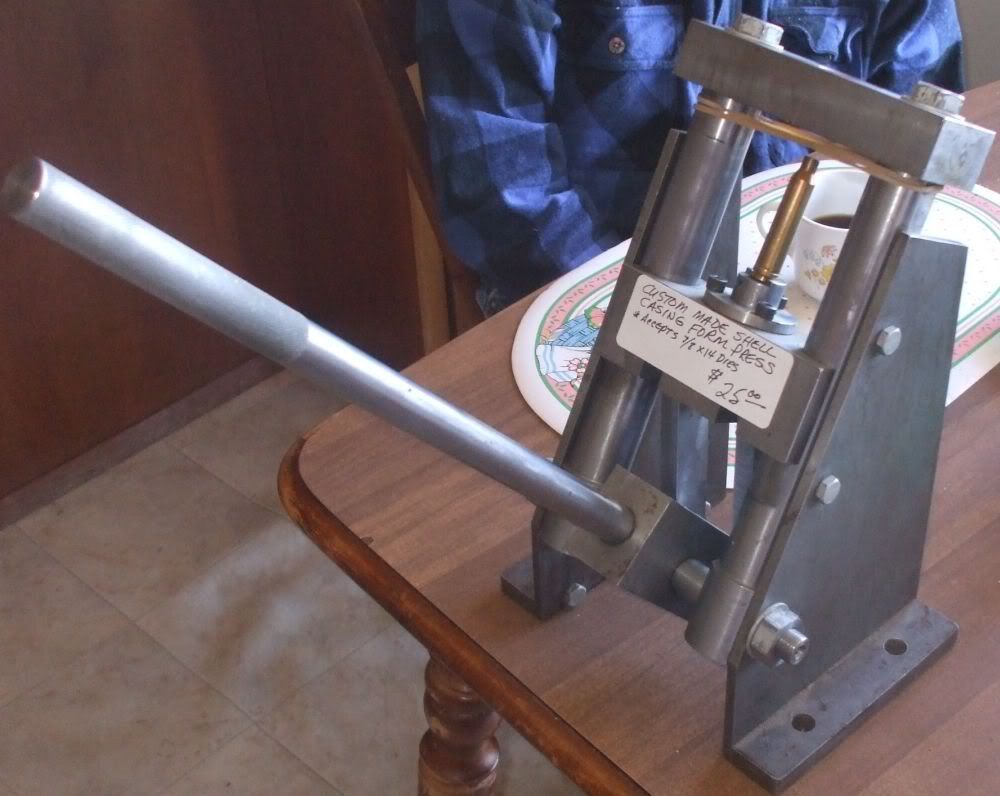I'm a machinist.I have access to machine tools .
I can chucka piece of round stock,turm it down,cut six flats to make a hex,and single point threads to the specs in a machinery handbook.I can make a bolt.
Its not what I choose to do with my time,because I can get a grade 8 bolt at the NAPA store.
But if I need a special bolt,drilled and tapped for a grease zerk,with holes drilled for grease ports .. I might make what I cannot buy.
So,I am interested in the "Why?" of making a press,given what is available.
Its pretty tough to pay for the steel billet to machine what someone else is making from castings. Cutters are expensive,and time is money.
You MIGHT make an ultimate press with a jig borer,Thompson linear shafting and bearings,or a punch press die base.But you won't save any money.
I agree with Uncle Nick (that always easy!) However you get co-axial ammo ,its the co-axial ammo you want.
How do you know you have co-axial ammo?? You see,ideas and experiments need to be measured...or you don't learn anything.
So,first build,or buy,a fixture with a dial indicator to check ammo runout.
Then try raising your ram on a store bought press to put an end load on your die before setting the lock ring.An O-ring under the lock ring is another trick.
What happens when you set a part in a vee block? It tries to center.Same with a center drill and lathe center,right?
Aren't threads sort of a spiraled 120 degree Vee,or cone? With an end load,threads are tapered surfaces that will find center. The die lock ring competes,and can throw things cockeyed,like an unsquare receiver face.The O-ring lets the threads be the master.The lock ring maintains a preload on the treads in the same direction press force is applied.
Nothing personal,Jeephammer,but the idea of putting the lock ring on from below probably puts the lock ring on a surface that,if it is not rough cast,was not machined in the same setup as the threads and ram bore.
And it preloads the threads in the direction of the slack.Will the ram force overcome the lock ring pre-load?
Consider and try all the theory,then measure the results with a dial indivator in your ammo co-ax fixture.
as Uncle Nick said,the Bonanza system relies on float. It works.
Collet sizing works.
There is more than one way.
Are you competing bench rest or deer hunting? Or plinking at cans?
When is ammo good enough? If extra hours at the press get your groups 1/4 MOA smaller,great!! If you are a benchrest competitor.
Or,in the same time,you might load 200 more "pretty darn good" rounds.
Then you can go SHOOT!
And maybe the practice will make YOU a 1/2 MOA better shooter.
Or you can make a reloading press.
I can chucka piece of round stock,turm it down,cut six flats to make a hex,and single point threads to the specs in a machinery handbook.I can make a bolt.
Its not what I choose to do with my time,because I can get a grade 8 bolt at the NAPA store.
But if I need a special bolt,drilled and tapped for a grease zerk,with holes drilled for grease ports .. I might make what I cannot buy.
So,I am interested in the "Why?" of making a press,given what is available.
Its pretty tough to pay for the steel billet to machine what someone else is making from castings. Cutters are expensive,and time is money.
You MIGHT make an ultimate press with a jig borer,Thompson linear shafting and bearings,or a punch press die base.But you won't save any money.
I agree with Uncle Nick (that always easy!) However you get co-axial ammo ,its the co-axial ammo you want.
How do you know you have co-axial ammo?? You see,ideas and experiments need to be measured...or you don't learn anything.
So,first build,or buy,a fixture with a dial indicator to check ammo runout.
Then try raising your ram on a store bought press to put an end load on your die before setting the lock ring.An O-ring under the lock ring is another trick.
What happens when you set a part in a vee block? It tries to center.Same with a center drill and lathe center,right?
Aren't threads sort of a spiraled 120 degree Vee,or cone? With an end load,threads are tapered surfaces that will find center. The die lock ring competes,and can throw things cockeyed,like an unsquare receiver face.The O-ring lets the threads be the master.The lock ring maintains a preload on the treads in the same direction press force is applied.
Nothing personal,Jeephammer,but the idea of putting the lock ring on from below probably puts the lock ring on a surface that,if it is not rough cast,was not machined in the same setup as the threads and ram bore.
And it preloads the threads in the direction of the slack.Will the ram force overcome the lock ring pre-load?
Consider and try all the theory,then measure the results with a dial indivator in your ammo co-ax fixture.
as Uncle Nick said,the Bonanza system relies on float. It works.
Collet sizing works.
There is more than one way.
Are you competing bench rest or deer hunting? Or plinking at cans?
When is ammo good enough? If extra hours at the press get your groups 1/4 MOA smaller,great!! If you are a benchrest competitor.
Or,in the same time,you might load 200 more "pretty darn good" rounds.
Then you can go SHOOT!
And maybe the practice will make YOU a 1/2 MOA better shooter.
Or you can make a reloading press.


